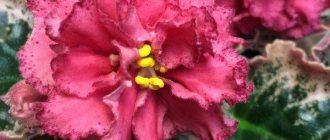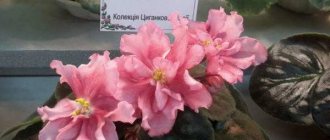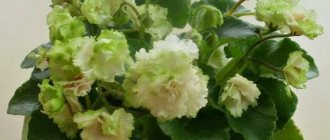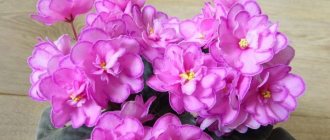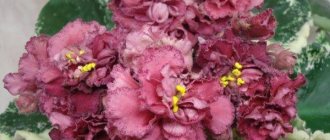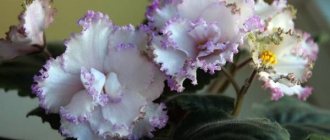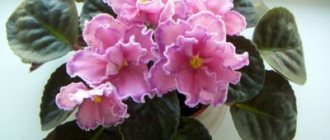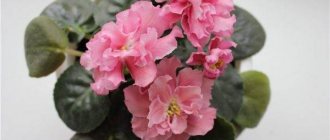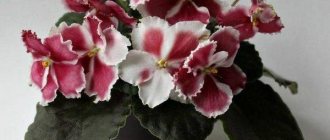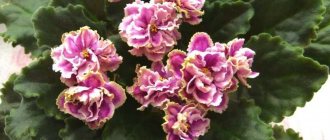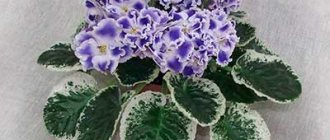When choosing a new violet for his collection, every gardener tries to learn as much as possible. For the correct and most productive cultivation of a variety, it is important to know all the nuances of care that are associated with it.
Saintpaulia SM-Forest Magic is not picky, but some nuances must be observed. Therefore, future owners should take seriously the preparation of living conditions and study the features of care.
Mind-blowing violet SM-Forest Magic (Seedling Morev)
When choosing a new violet for his collection, every gardener tries to learn as much as possible. For the correct and most productive cultivation of a variety, it is important to know all the nuances of care that are associated with it. Saintpaulia SM-Forest Magic is not picky, but some nuances must be observed. Therefore, future owners should take seriously the preparation of living conditions and study the features of care.
Violet SM-Forest Magic (Seedling Morev)
Violet SM-Forest Magic.
SM-Forest Magic, a modern variety from the genus of hybrid Saintpaulias, the Gesneriev class. This Uzambor violet was bred by breeder Konstantin Morev . You will see a photo and description of the variety below.
The rosette is a standard size, small, but stretches slightly upward , lengthening the stems of the leaves. Leaf plate:
- Round shape;
- With small teeth;
- And a clear pattern of veins.
The color of the front side is medium green, with a light green pattern that slightly resembles a girl leaf, the back side is light green .
The flowers are simple, sometimes semi-double, with a corrugated edge of the petals . Color:
- Very delicate, white is the main color;
- There are pink shading around the perimeter;
- The shade of which changes depending on the conditions of detention.
There is a corrugation along the edge of the petals , with a light green border.
Violet has unusually shaped flowers.
Sometimes there are individuals with rare light spots on the leaves , like spot variegation. These spots are more often observed on children's sheets, which are already lighter than adults. This sport is unstable in propagation and is therefore not a separate, registered variety.
Home care
The variety is unpretentious, but some rules must be followed .
Most of them can be called classic for all Uzambor violets. Like most Uzambor violets, SM-Forest Magic feels best in bright diffused light , without direct sunlight.
Under the lamps, the leaves stretch upward less, but even in such conditions a slight rise is observed. Daylight hours vary:
- From 8-10 hours – in winter;
- And up to 12-14 hours in the summer.
The temperature must be maintained within 16-24°C without sudden changes :
- The lowest temperature is the minimum for the winter period;
- And the top is the maximum mark for summer and the flowering period.
Many gardeners recommend not making transitions between seasons , and maintaining the temperature around 22-24°.
Each gardener chooses the type of watering for himself, and the choice of soil and fertilizer directly depends on this:
- In a tray - trays can be single (for one pot) or group (for several flowerpots at once), but it is better to choose a depth of about 2 cm. Water is poured into this container and the flower is allowed to drink for 20 minutes, after which the excess water is drained .
Watering Saintpaulia in a tray.
With this type of irrigation fertilizers are applied through irrigation , approximately once every two to three weeks, the concentration is halved from that recommended by the manufacturer.
The soil is suitable ready-made for violets or a mixture of peat, perlite and leaf soil in equal proportions with the addition of sphagnum moss, the amount is adjusted depending on air humidity;
- Under the leaves , water is added to the ground, the excess flows off and after a while it must be drained. The frequency and concentration of fertilizers, as well as the soil mixture, are similar to the previous option;
- Wick - place a wick in the pot, lower it into the lower, additional container through the drainage holes. The amount of fertilizer is calculated in proportion to 1/8 of the recommended dosage, and the plants are watered with this water constantly. For this type of irrigation, it is recommended to make a substrate of peat and perlite in a 1/1 ratio.
Reproduction is carried out in any convenient way, because the variety has no limiting factors.
Unlike chimeras, SM-Forest Magic reproduces well by leaf cuttings and stepsons; the lack of variegation allows the use of the peduncle method:
- Leaf cuttings - use material from 2-3 rows. Root in water, soil and moss. Children are separated when they grow to independence or no longer fit together;
- Stepchildren - planted after the appearance of their own roots, or cut off with 4-6 of their own leaves and rooted like a leaf cutting;
- Peduncles - unfaded peduncles are trimmed from the top of the peduncles, at a level of 0.2-0.5 cm above the leaflets (at the branching point of the peduncle), it is not necessary to trim the bottom. Root in the ground, under the film.
Reviews
I don’t like pale varieties, so I gave them to friends. Everyone likes different things, but I need something that catches my eye.”
Violet pleases gardeners with its appearance.
I put a pot of violets on wick watering, and it gave good results. The rosette has grown a little, but at the same time has not lost its external parameters, and the flowers seem to have increased even more.”
Features of flowering, growth and reproduction
SM-Forest Magic grows and forms beautifully at home .
The variety does not require additional lighting, and even on a windowsill it easily forms an even rosette. Regardless of the lighting, the leaves tend to stretch upward and their cuttings become elongated. The first flowering usually occurs a little earlier than the rosette matures:
This variety is quite easy . The absence of limiting factors gives flower growers the opportunity to use all available vegetative propagation methods.
Peduncles:
- Quite strong;
- Middle length;
- Reach towards the center of the socket;
- Creating a lush bouquet.
Reviews
Anastasia, Voronezh. “Compact bush, flowering in full bloom for the first time. The peduncles are erect, the flowers stand upright for more than a month, and then they become thin and dried out, like paper. The second time it bloomed much paler, I thought something was wrong, but I asked the collector from whom I bought it, and it turned out that this first bloom was surprisingly bright. I don’t like pale varieties, so I gave them to friends. Everyone likes different things, but I need something that catches my eye.”
Violet pleases gardeners with its appearance.
Alexander, Tomsk. “I really like the variety. Its delicate blooms simply captivate me. The first buds were collected in a beautiful bouquet and were quite bright in color. Starting from the second planting, the size of the flowers increased and the color became much paler, but this did not affect the border and ruffle.”
Marianna, Perm region. “I bought the baby SM-Forest Magic, I really love this color of the flowers. It grew quickly for me, and bloomed for the first time already at 8 months. The first buds were a little smaller than I thought and slightly brighter. When the flowers appeared the second time, I was very happy, because the shade was exactly what I wanted, and they also became bigger. I put a pot of violets on wick watering, and it gave good results. The rosette has grown a little, but at the same time has not lost its external parameters, and the flowers seem to have increased even more.”
Violet, description and photo Forest Tale (B. Makuni)
Violets from breeders of the CIS countries - “L”.
Forest Tale (B. Makuni).
Large semi-double and double flowers of pink color with greenish-white wavy fringed edges of the petals.
The leaves are dark green, elongated, toothed, slightly wavy, collected in a compact rosette. The socket is standard, really good. The leaves are round, pointed at the ends, slightly toothed, dense, slightly pubescent, dark, 6-8.5 cm in size.
The flowers are double, pink, with a persistent greenish-white petal edge. The flowers are single, creamy pink, very light, especially along the edge, 4-4.5 cm in size.
Light, modest flowers against the background of dark leaves look like wild forest violets. The flowers are almost like clones of each other, and this is already an exhibition quality of the variety. The ruffle is green, despite the heat in the apartment. Peduncles are strong.
Of course, it is inferior to Forest Magic in terms of color saturation, but the rosette behaves much better.
Do you know that…?
How to determine if there is enough light? The plant itself will tell you this: if the young leaves in the center of the rosette develop freely, the flower stalks rise safely above the leaves, then the lighting is normal. If there is not enough light, the petioles of the violet lengthen, the leaf blade becomes thinner, increases in size, and often the leaves are arranged vertically, the leaves stretch upward, and in variegated varieties the variegation disappears. And the plants themselves stop blooming and growing. Variegated foliage appears better in good bright light and becomes more pronounced.
If there is too much light, with too long daylight hours (more than 14 hours), the plant, on the contrary, will lower the leaves down and bend them over the edge of the pot, their color will become very light, almost yellow. The petioles of the leaves are shortened, the young leaves in the center of the rosette are deformed, resting on the lower tier, and the center of the rosette thickens. “Burns” appear on the leaves themselves in the form of brown spots. At the same time, the flower stalks develop short, they seem to hide under the leaves, it is difficult for them to get out of the thickening formed in the center of the rosette. The color of many varieties changes, the border, fantasy, greenery in the flower disappear, and darkening occurs. The flowers become smaller, turn pale and quickly fade.
Before you buy the violets listed below, carefully read the forums about their behavior on the windowsill. Many of them are very beautiful flowers. However, these can be large rosettes with large and fragile leaves, with leaves rising up or hugging the pot, forming many stepsons that interfere with the formation of a neat rosette, pulling the stem up and growing into a Christmas tree, bending the trunk, rare flowering with long breaks, fallen flowers or they last little and quickly wither, very long and recumbent peduncles, the color of the flower fades quickly, they do not like bright lighting on the windowsill, they are afraid of the slightest drying out or waterlogging, a large percentage of them go into sports or darken the flower.
Are they suitable for your window sill and the conditions that you can create for them? You will look at the flowers for several months, and the rosette will always be in front of your eyes. There are many beautiful flowers, there are much fewer beautiful and neat rosettes, look first at the rosette! Search and you may find a dozen violets with the same flower color if you are not interested in the smallest details as a collector.
• — Swan Flight (Makuni); • — Forest Magic (Makuni);
Features of flowering, growth and reproduction
SM-Forest Magic grows and forms beautifully at home . The variety does not require additional lighting, and even on a windowsill it easily forms an even rosette.
Regardless of the lighting, the leaves tend to stretch upward and their cuttings become elongated. The first flowering usually occurs a little earlier than the rosette matures:
- Maturity is approximately one year;
- Flowering in 9-10 months.
This variety is quite easy . The absence of limiting factors gives flower growers the opportunity to use all available vegetative propagation methods.
Important! Flowering is caplike, starting from the first time.
Peduncles:
- Quite strong;
- Middle length;
- Reach towards the center of the socket;
- Creating a lush bouquet.
The buds bloom gradually and last for about a month, after which they become like paper.
The color of flowers can change depending on the air temperature.
The color of flowers depends quite seriously on the temperature :
- In hot weather, the pink color predominates and becomes darker, and the light green border may partially disappear;
- In cool weather, the petals become almost white, and the ruffle is bright and slightly wider.
Forest violet and its characteristic features
Forest violet or Viola (from the Latin Viola) is a modest, delicate and beautiful flower of the northern latitudes. Various sources describe from 500 to 700 species of this wild plant of the Violet family. They grow primarily in the Northern Hemisphere in areas with moderately cold climates.
The plant is native to East Africa. Viola was first shown at an exhibition in 1893. Since then, cultural selection of flowers began.
Most species are found in North America and Japan. But wild violet grows in the Andes, Australia and New Zealand. In Russia, cultivated varieties are more common - Pansies.
The herb of individual forest violets has medicinal properties.
Forest violet: characteristics of the best varieties for indoor growing
There are more than five hundred varieties of violets in the world. They can be found in the wild and also bred as a garden or houseplant. Some types of violets are favorite plants in flower beds. Being an excellent honey plant, the flower is also used as a remedy. For medical purposes, the description of forest violet is suitable for the treatment of headaches, as an expectorant, anti-inflammatory, diuretic, disinfectant, sedative and blood purifier.
Tricolor violet can be used as a remedy to combat fever, allergies, or as a diuretic.
Types of forest violets
In Russia, about 20 species are found in natural conditions:
| Name | Growth | Description of flowers | Flowering period |
| Tricolor (Pansy) | In the forest and countryside - on arable land, in vegetable gardens, like weeds. | The upper two petals are blue, the lower three are white, and the center is yellow. | May – September |
| Doggystyle | On the edges, in sparse young growth and in the field. | Small, even blue color. | May |
| Bolotnaya | Damp places are not only swamps, but also mossy forests and water meadows. | Light blue, almost white with dark veins. | May – August |
| Field | Fields, forest clearings, forest edges, roadsides. | Similar to the Tricolor, but white, miniature with a bright yellow mouth. Height up to 30 cm. | April – September |
| Fragrant | Forest | Purple, bright blue, with a pleasant sweet aroma. | April May. |
| Altai | Mountain slopes. | Violet-blue with a yellow center. Height up to 20 cm. | From the end of April 40-45 days. Repeatedly in September until the first snow. |
| Yellow | Fertile soils of sparse, well-ventilated forests. | Yellow-green, bright. There are purple veins on the back of the petals. | June July. |
| Kholmovaya | In light forests, on open slopes, under bushes. | Light blue, occasionally purple, fragrant. Large, on a long peduncle. | May June. |
| Notched | Endemic to Siberia. Not found in other areas. | Bright purple, graceful, raised above the bush. The shape resembles cyclamen. | June July. |
| Aetolian | Sunny places, loose soils, rocky ledges. | The upper petals are yellow, the lower petals are orange. | From May and all summer. |
| Dubravnaya (mountain) | In the European part of Russia, at the foot of the Caucasus Mountains, in the south of Siberia. | Light blue, similar to dog violet flowers, but larger, and the stem is higher - up to 25 cm. | May – July. |
| Peach leaf (pond) | Rarely found in central and some regions of Siberia. | Long peduncles, small flowers of a characteristic milky white color with blue. | May June. |
| Purple | A rare species, it grows only in the Caucasus mountains. | It blooms profusely with small purple flowers, collected in an inflorescence-spike of 20 pieces. Pleasant, but doesn't smell much. | Twice – in spring and autumn. |
Sowing seeds and caring for forest violets
The seeds germinate three weeks after planting. Moreover, they can be sown in spring, summer and autumn. Only freshly harvested seeds are used, as they lose their viability the following year.
You can grow seeds and seedlings. To do this, take ordinary leaf soil, add sand, peat and a little humus to it. The small achenes are simply laid out on top of the loosened soil and lightly sprinkled. Then the area is moistened and covered with film.
The only thing that is required after the seeds are in the ground is daily watering and aeration until germination.
Field violet is easily propagated by seeds. It is easier and faster to plant forest plants by digging up the budding rosettes of leaves. This is done after spring flowering. In the fall, plants may not have time to take root before frost.
They dig up an adult bush and select young rosettes with roots, which will serve as planting material. Large bushes are planted one at a time, small bushes - two at a time. The distance between seedlings is 20-30 cm.
So, already in the second year the forest violet will bloom in the garden or under the window.
The advantage of the plant is that it does not require constant careful care. The wild violet winters quietly without shelter and is drought-resistant. It prefers shaded areas of the garden, but can also grow in sunny meadows if you don’t forget to water it.
Viola reproduces well by self-sowing. In this she is assisted by garden ants, who carry the seeds around the area.
Fertilizing with regular humus infusion or complex fertilizers for flowering plants. But this is exactly the plant that is better to underfeed than to overfeed. For better rooting, young shoots are mulched with light humus.
In shady places, viola flowers are paler, but flowering lasts longer. She doesn't like stagnant water in the soil - she starts to get sick. Therefore, it is better not to grow it in the lowlands.
The creeping nature of the shoots is advantageous on gentle slopes and alpine hills, where forest violets grow to form a blooming carpet.
We must be prepared for the fact that the plant may fill more than the area allocated for it. In such cases, it will be necessary to remove the shoots by pinching or cutting them, like the mustache of garden strawberries.
Diseases of forest violet
The worst enemy of violets is disease.
| Disease, pests | Signs | Causes, pathogens. |
| Root rot | The roots rot, then the stem and leaves. The plant dies. | Pathogenic fungi that can remain dormant in the soil for a long time. Fungal disease occurs at low temperatures and high humidity. An acidic soil environment contributes. |
| Gray rot | Gray fluffy coating on the upper parts - peduncles and seed pods. | |
| Powdery mildew | A white coating in the form of powder on leaves and flowers. Most often occurs in early summer. | |
| Rust, spotting | Brown spots on green parts of plants. Drying. | |
| Smut | Swelling blisters on the petioles and leaves, filled with dark liquid. | |
| Blackleg | Disease of seedlings and seedlings. The base of the stems darkens, the leaves droop. Death occurs within 3-4 days | |
| Late blight | Penetrates through the pistil or thin roots. | |
| Variegation | The leaves acquire a variegated, marbled color, dry out and die. | Virus. Carried by aphids. |
| Ring mosaic | Rings of dark green color on the leaves followed by necrosis. | |
| Clover cutworm (pearl cutworm) | The tips of the leaves are eaten away. It develops from May to July during the feeding period of the larvae. | Moth larvae with a wingspan of no more than 4.5 cm. Orange with black speckles, the back side of the wings is silvery-pearl. |
| Nematode | The above-ground parts or roots are affected, depending on the type of parasite. Plants are oppressed, lag behind in development, and their decorative properties suffer. | Parasites – aerial and ground nematodes (strawberry, root-knot). |
Fighting diseases of wild violets is very difficult. Often the entire plantation dies. If the species is rare and it is not possible to restore it, you should still try to save the plant.
Diseased parts are removed and affected plants are destroyed. For survivors, they are sprayed with special antifungal drugs and potassium-phosphorus fertilizers are applied.
Use in folk medicine
The plant contains large quantities of essential oils, flavonoids, vitamins A, C, E, fats, and carotene. Due to the alkaloids it contains, it is poisonous. Therefore, it should be used in home medicine with caution. It would be best to consult a doctor.
Forest violet helps in the treatment of many diseases with folk remedies:
- Febrifuge.
- Gargle with a decoction for inflammation.
- Promotes the separation of mucus from the respiratory tract.
- Treats headaches.
- Has a diuretic effect.
- Has disinfecting properties.
- Hemostatic - for women with complications after childbirth and during menopause.
- Anti-allergenic, helps with diathesis in children.
- Antirheumatic (in the form of compresses)
In aromatherapy, the smell of violets calms the nerves, even helps with excitability, hysteria, and seizures. Increases vitality and immunity.
In cosmetology, violet oil smoothes wrinkles, heals cracks and chapped lips. In high concentrations, violet extract is poisonous. Therefore, violet-based preparations should be used with caution and kept out of the reach of children.
Forest violet: characteristics of the best varieties for indoor growing
There are more than five hundred varieties of violets in the world. They can be found in the wild and also bred as a garden or houseplant. Some types of violets are favorite plants in flower beds. Being an excellent honey plant, the flower is also used as a remedy. For medical purposes, the description of forest violet is suitable for the treatment of headaches, as an expectorant, anti-inflammatory, diuretic, disinfectant, sedative and blood purifier.
Tricolor violet can be used as a remedy to combat fever, allergies, or as a diuretic.
